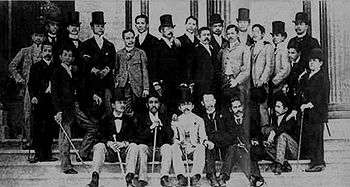Propaganda Movement
The Propaganda Movement was a period of time when native Filipinos were calling for reforms, lasting approximately from 1880 to 1886[1] with the most activity between 1880 and 1895.[2]
Prominent members included José Rizal, author of Noli Me Tángere and El filibusterismo, Graciano López Jaena, publisher of La Solidaridad, the movement's principal organ, Mariano Ponce, the organization's secretary[3] and Marcelo H. del Pilar.
Specifically, the Propagandists aims were the following:
- Representation in the Philippines in the Cortes Generales, the Spanish parliament
- Secularization of the clergy (i.e. usage of secular or diocesan priest rather from a religious order)[4][5]
- Legalization of Spanish and Filipino equality
- Provision of Spanish citizenship to Filipinos
- Recognition of the Philippines as a province of Spain[6]
- Abolition of polo y servicios (labor service) and the bandala (forced sale of local products to the government)
- Guarantee of basic freedoms
- Equal opportunity for Filipinos and Spanish to enter government service
Dr. Domingo Abella, the learned Director of the National Archives, has made the suggestion that the so-called Propaganda Movement was misnamed. It should have been called the Counterpropaganda Movement because its essential task was to counteract the campaign of misinformation that certain Spanish groups were disseminating in Spain and later in Rome.[7] It was a campaign of information, as well as a bid for sympathy.
It is notable in contrast to the Katipunan or the "K.K.K.", whose aim is for the total independence of the Philippines from Spain, the Propaganda Movement's aim is for the total assimilation of the Philippines as a province of Spain, and not a mere colony. The word "propaganda" in English has acquired a pejorative connotation that is absent from the original Latin word. One can see its true meaning in the Roman institution called "Congregatio de propaganda fide" - the Secretariate for the Spread of the Faith (or, as the modern translation has it, For the Evangelization of Peoples). It was in the latter sense that the word was used by the Filipino group that sent Marcelo H. del Pilar to Spain to continue the "propaganda" on behalf of the Philippines.
References
- Agoncillo, Teodoro (1990). History of the Filipino People (8th ed.). Quezon City: Garotech Publishing. ISBN 971-8711-06-6.
- Schumacher, John (1997). The Propaganda Movement, 1880–1895: The Creation of Filipino Consciousness, the Making of the Revolution. Manila: Ateneo University Press. p. 333. ISBN 971-550-209-1.
- "Bulacan, Philippines: General Info: Heroes and Patriots: Mariano Ponce". Retrieved 2008-08-01.
- https://www.philippine-history.org/secularization-of-priests.htm
- http://catholicencyclopedia.newadvent.com/cathen/13677a.htm
- https://www.rlp.hds.harvard.edu/faq/propaganda-movement.htm
- Bernad, Michael (1974). "The Propaganda Movement:1880–1895". Philippine Studies. 22 (1–2): 210–211.
321213

